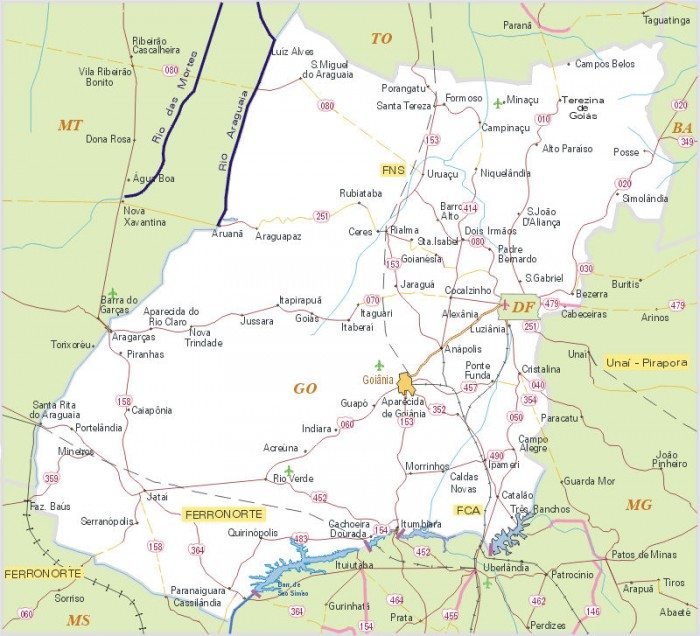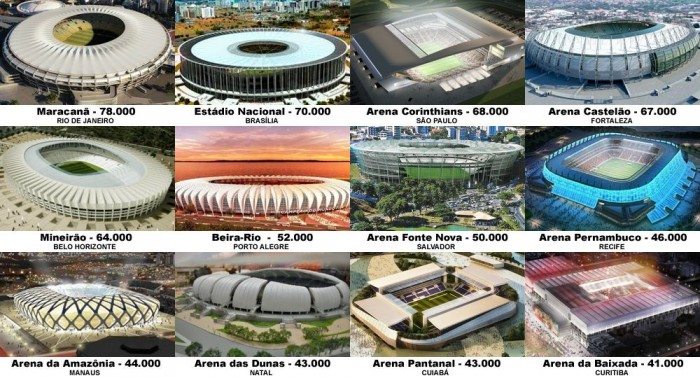In 2006, my parents, my grandmother, and I left Rio Verde for Jataí, Goiás to watch the World Cup Germany final between Italy and France at my great-uncle’s place. I happened to be in Brazil in 1994 and 2002 when Brazil won it all, so I had an idea of the parties for days that made Carnival those years seem a lot smaller. The mood was quite different for this final for one simple reason: no Brazil. It was still worth the head-butt felt around the world and some very clever wordplay from my 75-year-old grandma at the time (France knocked out Brazil, so not a lot of amour): “Se dane, Zidane!” They almost sound the same, but it means “F— you, Zidane!”
At this point, FIFA hadn’t decided the country, but it was clear the 2014 World Cup would be coming back to South America after a long hiatus, and the speculation was that it would be awarded to Brazil. I remember us talking and my relatives agreed it should be easy because, “there are World Cup quality stadiums everywhere. It’s the country of football, after all.” There was excitement about the prospect of Goiânia, Goiás, hosting at the Serra Dourada stadium. It was ready and had hosted a fair number of internationals and even had the seleção, the national team, play there a handful of times. I brought this up later to my great-aunt in Goiânia and her response: “It makes sense, but it’s early. Just wait.” My Tia Elcia, the prophet.
Whether you’re a fan of the world’s game or not, there is certainly a buzz about the 2014 World Cup in Brazil kicking off in less than a month. Unfortunately, most of that buzz hasn’t been very good news. At this point, most people have heard about the protests of last summer, with varying degrees of understanding from those reporting on the events. The tragic number of eight deaths on stadium construction sites has also been well-documented. This week, protests spread across the country.
Less has been said about the ridiculous stadium price tags swindled from the Brazilian taxpayers, just like what happens with publicly-funded stadiums in this country. So most people know something about what has been happening in Brazil. Somehow, I’ve ended up being the guy my friends come to for more information.
Just to clear the air: I’m no expert on all things Brazil or all things futebol, or football, I mean soccer. I am, however, a diehard fan of both my Brazilian club and national teams, and I do have a Brazilian passport. I guess that’s enough for some, because I’ve been asked many questions since 2007 when FIFA granted Brazil the 2014 World Cup. It’s funny how quickly the questions changed from “Are you going?” to “What’s going on with Brazil?” to the most common this past year, “Why aren’t they ready?” If I’m in a rush, my quick response is: “Read some Dave Zirin.” If I have time, I’ve found myself constantly repeating the same more personal story that ties it all together.
After going over it again recently, I finally decided I should just get it out there for the general public in the hope that it may help in understanding how easy it could have been to take a different path. How clearly my great auntie, my Tia Elcia, saw it all. How, if my Tia saw it, then someone between FIFA, CBF (Brazilian Football Confederation), and the Brazilian politicians also saw it, but the corruption was so deep it led them to ignore what was in front of their faces to line their pockets. I admit that I’m dealing with some hypotheticals here, and hindsight is 20/20, but I think this example makes for a powerful case. In a parallel universe, if my Tia would have been in charge of it all, I think the negative things that have happened could have been avoided. At the very least, we would be in a much better place a few months before the greatest and most popular sporting event on Earth begins.
As mentioned before, my family hails from the Brazilian state of Goiás. Most tourists know nothing of this state, because most tourists want the beach. I get it, I do too. Goiás is landlocked on a unique tropical savanna of biodiversity called the cerrado. Most folk don’t samba. In fact, the regional music is closer to something like Tejano, called música sertaneja. Related are the cowboy hats and belt buckles the size of your shoe that are regularly seen. Think the Midwest with a healthy shot of Texas. Goiás and the surrounding states are like the agricultural and livestock supply for the beach bums in Rio and the suits in São Paulo. My father is from the U.S., from Nebraska. Though he had to learn the language, culture-wise, with his agronomy degree, you could say he never left Nebraska when he first landed in Goiás.
Goiânia is the largest city and the state capital with over two million in the metro area. My Tia Elcia has greeted us in Goiânia at the start and end of our family pilgrimages for three decades. Tia Elcia was my mom’s favorite aunt and they had a very special relationship. Because of this, we also became very close, and especially as I got older we could dive into politics. When it came to Brazilian League soccer, my uncles always pushed me as a kid to support one of the big teams from Rio, like Flamengo. They’re probably also the most famous Brazilian club team. If you’ve seen the red and black horizontal stripes, yep, you know. My Tia, on the other hand, told me when I was eight: “You’re in Goiás. Your family and roots are here. You should think about the green shirt.” The hole had been dug, and in I fell. I had a club team from that moment with a crest similar to the Green Bay Packers and a mascot that happens to be a rabid parrot. Sweet.
The “green shirt” she referred to represents Goiás Esporte Clube (aka Goiás E.C., aka Goiás, aka Verdão, “the big green.” That’s right Palmeirenses!). Goiás has never been an amazing team in the Brazilian League. They also haven’t been a horrible team. They are painfully mediocre, ranked 13 out of the top 30 teams by CBF. That said, while there have been plenty of times of pain that I won’t dwell on here, there have been a few recent “almosts.” The biggest deal in club history was a top four finish in the A League in 2005 that qualified them for their first and only appearance in the Copa Libertadores (the South American version of Champions League) in 2006. They won their group, but were knocked out in the round of sixteen. After being relegated to the B League, they “almost” won the Copa Sul-Americana (like Europa League) in 2010, losing in the final. And last season in the A League they “almost” qualified for Libertadores again, blowing it all on the last game of the season. A win or a draw and they were in. They got smoked by Santos. I shut that one off at half-time.
There are two other teams in Goiânia, and the rivalries are fierce. To accommodate the teams’ growing fan bases, in March 1973 ground was broken for the construction of a new stadium to compete with the big teams’ pitches in the A League. Close to exactly two years later, the Serra Dourada, “the golden hills,” taken from a historical gold rush and a type of sand on the hills that reflects the sun, opened its door to a special exhibition match between the Goiás All Stars against Portugal. Over 70,000 people packed the stadium as the boys from the state beat the international squad. The Serra Dourada is a nice stadium. Similar to my team that it hosts, it’s not jaw dropping amazing, but that said; it’s certainly worthy of the big games. The capacity is normally around 50,000. That number is important, because FIFA has a very specific capacity number when deciding on World Cup-worthy stadiums. That number: 30,000 minimum. In 2008 a list of the potential host cities for the 2014 World Cup was released. The former head of CBF, Ricardo Teixeira, a man of legendary corruption only eclipsed by his pals in FIFA, managed to change the number of host venues from the usual eight or 10, to 12. Both Goiânia and Brasília were on that list.
There is an island within the state of Goiás that will certainly ring a bell: Brasília. Like Washington D.C., it is the nation’s capital and a federal district. Landwise, it’s in Goiás, but it has its own very different politically-driven vibe.
In addition, soccer in Brasília takes a faraway nose-bleed backseat to all things politics. The teams are never in the A League, sometimes struggling for a B League place, and the citizens just don’t go out for the matches. I suppose too many tables to make deals under leaves the politicians with no free time. One of their “classicos” struggles to get five digits into the stands. Looking back, as my Tia Elcia later said, “No matter what’s here (in Goiânia), they weren’t going to let the capital lose.”
It was a stacked deck for the following two reasons: the distance between Goiânia and Brasília is 128 miles, about a two and a half hours drive. For Brazilian driving standards, comparable to driving in the Midwest, the cities are close. Too close for FIFA planning when they want to spread things out if the host nation happens to be a huge and geographically diverse country. In addition, it’s tradition for the nation’s capital to host in the World Cup. This point is particularly significant on the CBF end, because the last time Brazil hosted, in 1950, Brasília did not exist—Rio was the capital. So regardless of the fact that the stands had been consistently near empty at matches around the city, Brasília would not be denied. A year later when the final list was released and Goiânia didn’t make the cut, we were back in her apartment and Tia Elcia would swear under her breath whenever TV news mentioned the Cup.
The 2014 World Cup will go down in history as the most expensive World Cup ever. Estimated totals are over 10 billion dollars. Between 2010 and 2014, the total costs on stadiums nearly doubled from about two billion to four billion dollars. Billions, I repeat, in mostly public funding. Considering Russia is up next to host though, and we’ve seen what they’ve done with the Olympics, I’m guessing it will be an epic challenge in corruption.
Nowhere is this mess best seen than in Brasília’s Mané Garrinha Stadium. It’s comical that they called the stadium a “renovation” when the only thing that remained the same after the original stadium was annihilated was the name. It has the disgraceful honor of having the largest individual variation in construction cost in that same period. In 2010, they were looking at an estimated 330 million total. By this year, the price skyrocketed to nearly 620 million dollars. Part of this push was to secure the opening ceremonies and game. Millions were exchanged above and certainly below the table, not too surprising from a town where corruption is tradition. In the end, Brasília was not granted the opening. Federal Auditors found about 32 million dollars missing from public funds. Auditors found irregularities in landscaping expenses (135 million), purchased AV equipment (four million), and a laundry list of other money mismanagements from “relevant irregularities” to “restrictions on competitiveness” to “lack of clarity in definition of work projects.”
More numbers will come out in the future and it appears they will not be easy on the politicians in Brasília. It will be even harder on the citizens who see more and more numbers of just how much they have been robbed while their healthcare and kids’ public education wane. It’s no surprise that the fires of frustration were lit during the Confederations Cup. Much has not been resolved. If you’re not mad yet, remember those outstanding C and D League teams that will be thrilled to fill one tenth of the 71,000 capacity Mané Garrincha stadium. No sweat to pay off that cool half billion. To top off this savage capitalist terror is the worst tragedy: the death of José Rodrigues. He was a twenty-one year old carpenter’s apprentice that fell from a slab while working on the stadium in June 2012.
In my Tia’s opinion and mine as well, the solution rested 128 miles southwest in Goiânia: the Serra Dourada. Admittedly, in a parallel universe where somebody between FIFA and CBF picks the Serra Dourada, the stadium would still have needed some upgrades. But a half a billion dollars worth? Not even close.
While this is the example most personal to me, there were other cities in similar positions to Goiânia that were also snubbed to build something new in or close to a different region. Belém, on the Amazon river system, has the 45,000 capacity Mangueirão stadium. Instead, the 42,000 Arena da Amazonia was built in Manaus at a cost of around $275 million. If you haven’t heard, this is the stadium that had the appalling idea of turning the stadium into a prisoner processing center to help foot the bill post-World Cup. Like Brasília, there are no teams from Amazonas in the A or B Leagues. Florianópolis was a candidate, but would have required a new stadium as they don’t have a 30,000-seat stadium. However, regionally, Porto Alegre is a mecca of stadiums up there with Rio and São Paulo. The recently built Arena do Grêmio at 60,000 capacity was snubbed, so why build a new stadium in Porto Alegre other than the cross town rival wants their own too? The Beira-Rio is a new 51,000-seat stadium with a 145 million dollar price tag. Oh, almost forgot: there’s another empty 56,000 capacity stadium sitting there ready for demolition. Guess when? Right before the World Cup in May. This could have been a two birds, one stone situation: save the money on Beira-Rio and avoid the drama that has revolved around Curitiba’s Arena da Baixada, still only 85% percent done.
Rio Branco’s Arena da Floresta and Campo Grande’s Morenão were also ignored, both smaller ones and the latter is in pretty rough shape. In between them the new $210 million 43,000 capacity Arena Pantanal is currently being built. Again, not a lot of top soccer being played over one of the world’s largest swamps. Lovely land from what I’ve seen of my relatives’ photos, but how are they going to foot the bill afterwards? Something I think I’ll start adding when people ask me “Why aren’t they ready?” is: “Brazil has been ready for years, but they couldn’t ever have been ready for FIFA and CBF demands and the spineless politicians between them.”
My Tia Elcia had been battling cancer for a few years and things began to turn for the worst in 2011. When we saw her that year she didn’t seem like my feisty Tia. It was up and down for the next two years. During the Confederations Cup last summer, I got the news that my grandfather in his late 80s in Rio Verde was out on the streets protesting for “FIFA quality healthcare,” as some of the popular banners read, with family. That made me proud. After Confederations in July, he suddenly became ill and passed away. To make the summer just a little more unbearable, a month later in August 2013, his sister, my Tia Elcia, lost her battle with cancer and also left us.
As a tribute to both of them, especially my Tia who saw the coming storm and alerted me to it, I hope this one, very localized example, sheds some light on the bagunça, a great Portuguese word meaning “big mess,” that the 2014 World Cup has become. Who knows how things would have turned out had the players involved listened to reason and spent a fraction of the present total costs upgrading the existing stadiums I mention here? Judging from the early excitement of some of those cities like Goiânia, I think many more people would have been behind the projects knowing their teams and populations could support them after the event. Of course for these white collar criminals, logic never wins out over profit. It’s also hard to predict what will happen in June. The games will go on most likely, but protests or not, there is now a massive debt my family and millions of other Brazilians will carry to their graves in the country of football.
My Tia could have done it better.
***
Eric Silva Brenneman is a U.S.-Brazil dual national, a soccer-crazed fan and sometimes player, musician, teacher and a jack of other trades. Dabbling in journalism, he has been published by Zed Books in Shoot the Singer: Music Censorship Today and contributes to his neighborhood newspaper, The Corcoran News (Minneapolis, MN).









[…] e vilões da semana. Para escutar ou baixar o programa basta clicar no player abaixo. E clique aqui para ler a materia do Eric Silva […]
[…] My most recent, picked up by Latino Rebels:https://www.latinorebels.com//2014/05/15/if-only-my-auntie-ran-fifa-and-cbf-a-simple-solution-to-a-big… […]
After read a couple of the articles on your website these few days, and I truly like your style of blogging. I tag it to my favorites internet site list and will be checking back soon. Please check out my web site also and let me know what you think.
http://trio4d.com/
http://trio4d.com/promo-bagi-player-trio4d.html
http://trio4d.com/daftar-member.html
http://trio4d.com/cara-bermain-togel.html
http://trio4d.com/informasi-pasaran.html
http://trio4d.com/buku-mimpi.html